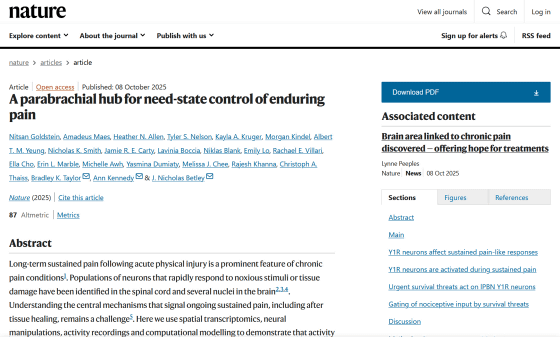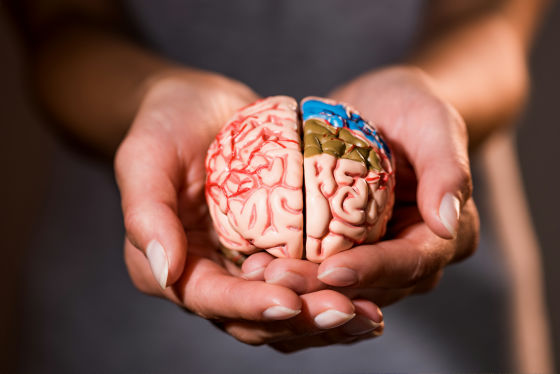The existence of a 'kill switch' in the brain that stops chronic pain is revealed, triggered by hunger, thirst, fear, etc.

The temporary pain we feel when we stub our toe or touch something hot can help us minimize physical damage and serve as a lesson to avoid future danger. However, chronic pain is different; the pain itself becomes a persistent problem, reducing the quality of life and productivity of many people. New research has revealed the existence of a 'kill switch' in the brain that stops chronic pain.
A parabrachial hub for need-state control of enduring pain | Nature

A built-in 'off switch' to stop persistent pain | Penn Today
https://penntoday.upenn.edu/news/select-neurons-brainstem-may-hold-key-treating-chronic-pain
Approximately 50 million Americans suffer from chronic pain, some of which can be untreatable and last for decades. 'It's not just an injury that won't heal,' says Nicholas Betley , an associate professor of neurology at the University of Pennsylvania. 'It's an overactive brain, hypersensitive brain input. Finding ways to calm that input could lead to better treatments.'
In this study, Nicholas, in collaboration with the University of Pittsburgh and the Scripps Research Institute, used calcium imaging , a technique that observes the concentration and movement of calcium ions within brain cells, to observe neuronal firing during both acute and chronic pain.
They found that neurons expressing Y1 receptors (Y1R) in the lateral parabrachial nucleus (lPBN) in the brainstem not only respond to transient pain but also continue to fire stably throughout the duration of pain, a state neuroscientists call 'tonic activity.'
Betley likens the tonic activity in Y1 receptor neurons to an engine that's been left idling. These neurons continue to hum along, emitting pain signals even after the outward signs of pain have faded. This persistent activity may contribute to persistent pain after an accident or surgery.

Furthermore, the research team found that urgent survival needs, such as hunger, thirst, and fear, can reduce persistent pain, supporting a model developed in collaboration with Scripps Research Institute that suggests that persistent pain may be blocked by filtering sensory input in the parabrachial nucleus in the presence of other, more intense needs.
'These results suggest that the brain must have a built-in mechanism for prioritizing survival needs over pain, so we wanted to find the neurons responsible for that switch,' said lead author
The research team identified a neurotransmitter in the brain, neuropeptide Y (NPY) , as the key to this switch. Neuropeptide Y is a signaling molecule that helps the brain process conflicting desires. When hunger or fear take priority, neuropeptide Y acts on Y1 receptors in the parabrachial nucleus, weakening persistent pain signals.
'It's like our brains have an override switch built in,' Goldstein said. 'When we're facing hunger or a predator, we can't afford to be overwhelmed by prolonged pain. Neurons activated by these other threats release neuropeptide Y, which silences pain signals and prioritizes other survival needs.'
'The study also characterized the Y1 receptors in the lateral parabrachial nucleus, revealing that they do not form an organized molecular cluster, but are scattered across many other cell types. 'We don't know the exact reason, but we suspect this mosaic distribution allows the brain to inhibit various types of pain input across multiple circuits,' said Betley.

'These findings open up the possibility of using Y1 receptor activity as a biomarker for chronic pain, leading to new drug development and treatment options. 'Currently, patients with chronic pain visit orthopedic surgeons and neurologists, but they experience persistent pain despite no apparent injury. What we're showing is that the problem may not be the nerves at the site of injury, but the underlying neural circuits in the brain. If we can target these neurons, we could open up entirely new avenues for treatment,' said Betley.
Furthermore, given that hunger and fear suppressed chronic pain, it may be possible that behavioral interventions such as exercise, meditation, and cognitive behavioral therapy could influence these neural circuits and reduce pain.
Related Posts:







